Electricity | Term 2 Unit 2 | 7th Science - Questions Answers | 7th Science : Term 2 Unit 2 : Electricity
Chapter: 7th Science : Term 2 Unit 2 : Electricity
Questions Answers
EVALUATION
I. Choose
the correct answers
1. In the
circuit diagram below, 10 units of electric charge move past point x every second What is the current
in the circuit ___________

a. 10 A
a. 1 A
c. 10 V
d. 1 V
Answer: a) 10A
2. In the
circuit shown, which switches (L,M or N) must be closed to light up the bulb?
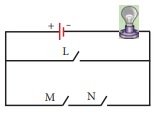
a. switch L only
b. switch M only
c. Switch M and Nonly M N
d. either switch L or switches M and N
Answer: d) either switch L or switches M and N
3. Small
amounts of electrical current are measured in milliampere (mA). How many milliampere are there in 0.25 A
?
a. 2.5 mA
b. 25 mA
c. 250 mA
d. 2500 mA
Answer: c) 250 mA
4. In
which of the following circuits are the bulb connected in series?

Answer: B
II. Fill
in the blanks.
1. The
direction of conventional current is opposite to electron flow.
2. One unit of coulomb is charge of approximately 6.242 × 1018 protons or electrons.
3. Ammeter is used to measure the electric
current.
4. In conducting materials electrons are loosely bounded with atoms.
5. S.I. unit of Electrical conductivity of a
conductor is
III. True or
False – If False give the correct answer
1. Electron flow is in the same direction to
conventional current flow.
Electron flow is in the opposite direction to conventional current flow.
2. The fuse wire does not melts whenever there is
overload in the wiring.
The fire wire melts whenever there is overload in the wiring.
3. In a parallel circuit, the electric components
are divided into branches.
4. The representation of the electric current is
A.
The representation of the electric current is I.
5. The electrical conductivity of the semiconductor
is in between a conductor and an insulator.
IV. Match
the following
1 .Cell - used to open or close a circuit
2. Switch - safety device used in electric circuit
3. Circuit - A complete path for the flow of an
electric current
4. Miniature - Reset by hand, circuit circuit becomes complete once Breaker again
5. Fuse - A device which converts chemical energy into electrical energy
Answer:
1 .Cell - A device which converts chemical energy into electrical energy
2. Switch - used to open or close a circuit
3. Circuit - A complete path for the flow of an electric current
4. Miniature circuit Breaker - Reset by hand, circuit becomes complete once again
5. Fuse - safety device used in electric circuit
V. Analogy
1. Water : pipe : : Electric current : wire.
2. Copper : conductor : : Wood :
3. Length : metre scale : : Current :
4. milli ampere: micro ampere : : 10-3A :
VI. Assertion
and Reason
1. Assertion
(A) : Copper is used to make electric wires.
Reason (R)
: Copper has very low electrical resistance.Option:
a. Both A and R are true and R is the correct explanation
of A.
b. Both A and R are true but R is NOT the correct
explanation of A.
c. A is true but R is false.
d. A is false but R is true.
e. Both A and R are false
Answer: A. Both A and R are true and R is the correct explanation
of A.
2. Assertion
(A): Insulators do not allow the flow of current through themselves.
Reason
(R) : They have no free charge carriers.
a. If both A and R are true and the R is correct
explanation of A.
b. If both A and R are true but R is not a correct
explanation of A.
c. If A is true and R is false.
d. If both A and R are false.
Answer : B. If both A
and R are true but R is not a correct explanation of A.
VII. Very
short answer
1. What
is the speed of electric current?
280,000,000 meters per
second.
2. What
is the S.I unit of electrical conductivity?
Siemens/meter (S/m)
3. Name
the device used to generate electricity.
Electric cell
4. Define
fuse.
The fuse is a wire that
melts whenever there is an overload of current in a circuit.
5. Name
some devices that run using heat effect of electric current
Electric stove, geyser,
room heater, electric iron.
6. Name
few insulators.
Rubber, plastics, glass,
wood.
7.
What is a battery?
A battery is a collection
of one or more cells in a circuit.
VIII. Short Answer
1. Define an electric current.
An electric current is a
flow of electric charge or the amount of charge flowing through a given cross
section of a material in unit time.
2. Differentiate
parallel and serial circuits.
Parallel Circuit — A circuit in which there are multiple paths
for electricity to flow. Each load connected in a separate path receives the
full circuit voltage, and the total circuit current is equal to the sum of the
individual branch currents.
Series Circuit — A circuit in which there is only one path for
electricity to flow. All of the current in the circuit must flow through all of
the loads.
3. Define electrical conductivity.
Electrical conductivity or specific conductance is the measure of a material’s ability to conduct an electric current.
IX. Long
Answer
1. Explain
the construction and working of an Telephone.
In telephones, a changing magnetic effect causes a thin sheet of
metal (diaphragm) to vibrate. The diaphragm is made of a metal that can be
attracted to magnets.
1. The diaphragm is attached to spring that is fixed to the
earpiece.
2. When a current flows through the wires, the soft - iron bar
becomes an electromagnet.
3. The diaphragm becomes attracted to the electromagnet.
4. As the person on the other end of the line speaks, his voice
causes the current in the circuit to change. This causes the diaphragm in the
earpiece to vibrate, producing sound.
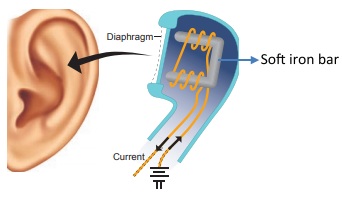
2. Explain
the heating effect of electric current.
When an electric current passes through a wire, the electrical
energy is converted to heat.
In heating appliances, the heating element is made of materials
with high melting point. An example of such a material is nichrome (an alloy of
nickel, iron and chromium).
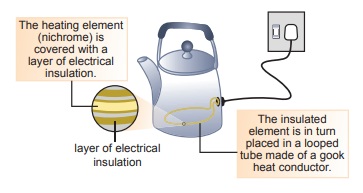
The heating effect of electric current has many practical
applications. The electric bulb, geyser, iron box, immersible water heater are
based on this effect. These appliances have heating coils of high resistance.
Generation of heat due to electric current is known as the heating effect of
electricity.
Factors affecting
Heating Effect of current
1. Electric Current
2. Resistance
3. Time for which current flows
3. Explain
the construction and working of a dry cell.
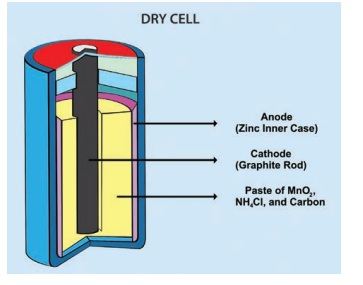
A dry cell is a portable form of a leclanche cell. It consists
of zinc vessel which acts as a negative electrode or anode. The vessel contains
a moist paste of saw dust saturated with a solution of ammonia chloride and
zinc chloride.
The ammonium chloride acts as an electrolyte. (Electrolytes are
substances that become ions in solution and acquire the capacity to conduct
electricity).
The purpose of zinc chloride is to maintain the moistness of the
paste being highly hygroscopic. The carbon rod covered with a brass cap is placed
in the middle of vessel. It acts as positive electrode or cathode.
It is surrounded by a closely packed mixture of charcoal and
manganese dioxide (MnO2) in a muslin bag. Here MnO2 acts
as depolarizer. The zinc vessel is sealed at the top with pitch or shellac. A
small hole is provided in it to allow the gases formed by the chemical action
to escape. The chemical action inside the cell is the same as in leclanche
cell.
X. Higher
Order Question
A student
made a circuit by using an electric cell, a switch, a torch bulb (fitted in the
bulb holder) and copper connecting wires. When he turned on the switch, the
torch bulb did not glow at all. The student checked the circuit and found that
all the wire connections were tight.
* What
could be the possible reason for the torch bulb not glowing even when the
circuit appears to be complete?
The filament in the bulb must be fused. The cell may be without
electric charge.
XI Picture
based Questions
1. Three
conductors are joined as shown in the diagram
The
current in conductor RS is 10 A. The current in conductor QR is 6 A. What will
be the current in conductor PR
a. 4 A
b. 6 A
c. 10 A
d. 16 A
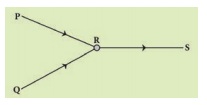
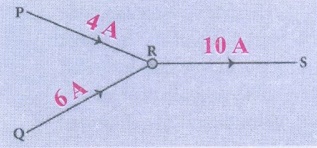
Answer : a) 4 A
2. Draw
the circuit diagram for the following series connection
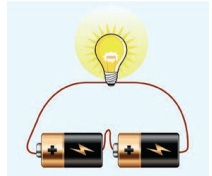
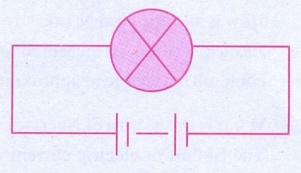
3. Study
the electric circuit below. Which of the following switches should be closed so
that only two bulbs will light up
a. S1,S2
and S4 only
b. S1, S3
and S5 only
c. S2, S3
and S4 ony
d. S2, S3
and S5 only

Answer : a) S1,S2 and
S4 only
4. Study
the three electric circuits below. Each of them has a glass rod (G), a steel
rod (S), and a wooden rod (W).
In which
of the electric circuits would the bulb not light up .
a. A only
b. C only
c. A and
B only
d. A , B
and C
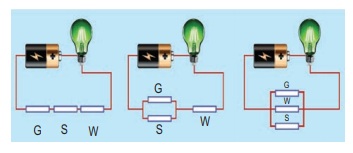
Answer : c) A and B
only
Related Topics